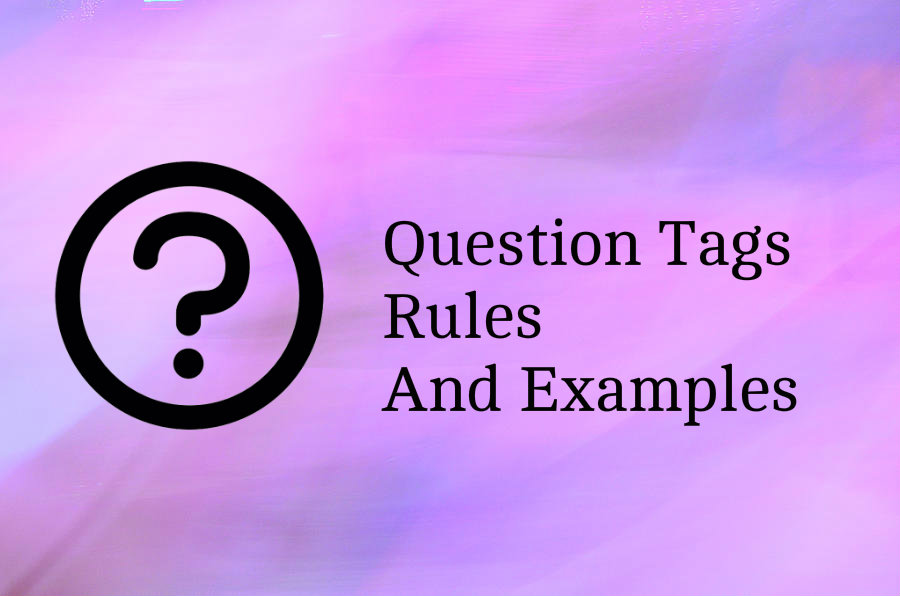In English grammar, while asking any sort of question we tend to make use of auxiliary verbs (helping verbs) and also modal verbs. If in case you are expecting the answer to be in ‘Yes’ or ‘No’ form then it is needless to say that the question will start with an auxiliary or modal verb.

What are Question Tags?
Question tags are the short questions which are used at the end of the sentence. It is used to confirm if the statement is meant to be true or not. Sometimes it is also used to evoke a reply from the person to whom the speaker is asking.
| Note: The Subject of the question tag is always a pronoun. |
Examples of Questions Tags
Following is a list of examples for question tags to understand how they are used to ask question at the end of statement.
- The weather is getting very hot, isn’t it?
- Paul can’t drive at night, can he?
- Maya would be able to bring the snacks for the party, won’t she?
- You have already completed your task, haven’t you?
- They have not been at the marriage yet, have they?
- He can swim in the river, can’t he?
- You would be needing an extra bag for the trip, won’t you?
- I guess her parents are too old to travel, aren’t they?
- You need to remember all the facts about the monument, won’t you?
- Luna basically belongs to Korea, doesn’t she?
- The Food is really tasty today, isn’t it?
- I think this music is heavy metal music, don’t you?
- John just topped in the entire university, didn’t he?
- I have heard that your brother paints really well, doesn’t he?
- You will be coming with us to the airport, aren’t you?
- You are residing in the west zone of the city, don’t you?
- Maya can’t speak Spanish, can she?
- You haven’t met Megha’s brother, have you?
5 Rules of Correctly Forming Question Tags
- Make sure that you use the right auxiliary verb in the sentence.
- Ensure the use of the correct pronoun in the question tag.
- Decide whether the question tag should be in the positive or negative form.
| Note: We can use affirmative tag questions after affirmative sentences to express a reaction such as surprise or interest. |
These question tags can be used in five different ways :
- Negative Form
- Positive Form
- With Auxiliary Verb
- Without Auxiliary Verb
- With modal verbs
1. The Negative Form of Question Tags
While writing sentences, and the main sentence clause is positive and you wish to make it negative then follow a simple rule.
Rule – Use Auxiliary Verb + n’t + Subject
Examples of negative question tags:
- You have already completed your work, haven’t you?
- Phoebe broke the wooden panel, didn’t she?
- I have heard that your sister cooks really well, doesn’t she?
- She can swim in the pool, can’t she?
2. The Positive Question Tags
If in case, you are forming the sentences and the main sentence is negative then the question tag has to be positive. Just follow the pattern to understand.
Rule – Auxiliary Verb + Subject
Example sentences of positive question tags:
- You won’t be busy with work, are you?
- Mohit can’t drive at night, can he?
- John does not seem to work hard, does he?
- They have not been at the party yet, have they?
3. Question Tag in Imperative Sentences
We use phrase ‘Won’t You’ at the end of imperative sentences to write question tags.
- You will enter the Gurudwara today, won’t you?
- Meera will be helping her little brother to complete his homework, won’t she?
4. If One Subject/Noun/Pronoun in Sentence, Then Use Pronoun in Question Tag
If in case, there is just one subject or noun/pronoun in the sentence, then the corresponding pronoun will be used in the sentence for asking question.
Let’s explore some examples to see how questions tags used with pronouns to ask short questions.
- The weather is really lovely today, isn’t it?
- Meera is attending the exhibition tonight, isn’t she?
Conclusion:
Now, you are well aware of the different question tags and how it can be applied to bring out the complete meaning of the sentences. Keep learning!
Quick Links

